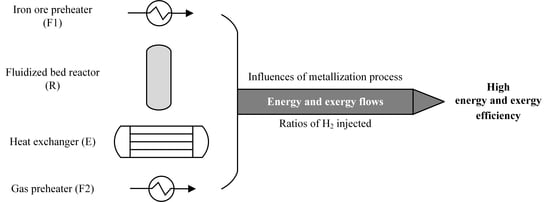Energy and Exergy Analysis of Hydrogen-Based Fluidized Bed Direct Reduction towards Efficient Fossil-Free Ironmaking
Abstract
:1. Introduction
2. Method
2.1. Description of the H-FBDR Process
2.2. Energy Analysis
2.3. Exergy Analysis
3. Results and Discussion
3.1. Influence of Metallization Process in the Fluidized Bed
3.2. Influence of H2 Injected into the Fluidized Bed Reactor System
4. Conclusions
Supplementary Materials
Author Contributions
Funding
Data Availability Statement
Acknowledgments
Conflicts of Interest
References
- Quader, M.; Ahmed, S.; Dawal, S.; Nukman, Y. Present needs, recent progress and future trends of energy-efficient Ultra-Low Carbon Dioxide (CO2) Steelmaking (ULCOS) program. Renew. Sustain. Energy Rev. 2016, 55, 537–549. [Google Scholar] [CrossRef]
- Vogl, V.; Åhman, M.; Nilsson, L. Assessment of hydrogen direct reduction for fossil-free steelmaking. J. Clean. Prod. 2018, 203, 736–745. [Google Scholar] [CrossRef]
- Zhao, J.; Zuo, H.; Wang, Y.; Wang, J.; Xue, Q. Review of green and low-carbon ironmaking technology. Ironmak. Steelmak. 2020, 47, 296–306. [Google Scholar] [CrossRef]
- Ariyama, T.; Takahashi, K.; Kawashiri, Y.; Nouchi, T. Diversification of the ironmaking process toward the long-term global goal for carbon dioxide mitigation. J. Sustain. Metall. 2019, 5, 276–294. [Google Scholar] [CrossRef]
- Tang, J.; Chu, M.; Li, F.; Feng, C.; Liu, Z.; Zhou, Y. Development and progress on hydrogen metallurgy. Int. J. Miner. Metall. Mater. 2020, 27, 713–723. [Google Scholar] [CrossRef]
- Li, F.; Chu, M.; Tang, J.; Liu, Z.; Zhou, Y.; Wang, J. Exergy analysis of hydrogen-reduction based steel production with coal gasification-shaft furnace-electric furnace process. Int. J. Hydrogen Energy 2021, 46, 12771–12783. [Google Scholar] [CrossRef]
- Ma, K.; Deng, J.; Wang, G.; Zhou, Q.; Xu, J. Utilization and impacts of hydrogen in the ironmaking processes: A review from lab-scale basics to industrial practices. Int. J. Hydrogen Energy 2021, 46, 26646–26664. [Google Scholar] [CrossRef]
- Schenk, J. Recent status of fluidized bed technologies for producing iron input materials for steelmaking. Particuology 2011, 9, 14–23. [Google Scholar] [CrossRef]
- Hasanbeigi, A.; Arens, M.; Price, L. Alternative emerging ironmaking technologies for energy-efficiency and carbon dioxide emissions reduction: A technical review. Renew. Sustain. Energy Rev. 2014, 33, 645–658. [Google Scholar] [CrossRef]
- Du, Z.; Liu, J.; Liu, F.; Pan, F. Relationship of particle size, reaction and sticking behavior of iron ore fines toward efficient fluidized bed reduction. Chem. Eng. J. 2022, 447, 137588. [Google Scholar] [CrossRef]
- Oscar, H.; Magnus, T.; Du, S. Experimental study on hydrogen reduction of industrial fines in fluidized bed. Ironmak. Steelmak. 2021, 48, 936–943. [Google Scholar] [CrossRef]
- Wang, R.R.; Zhao, Y.Q.; Babich, A.; Senk, D.; Fan, X.Y. Hydrogen direct reduction (H-DR) in steel industry—An overview of challenges and opportunities. J. Clean. Prod. 2021, 329, 129797. [Google Scholar] [CrossRef]
- Li, S.; Zhang, H.; Nie, J.; Dewil, R.; Baeyens, J.; Deng, Y. The direct reduction of iron ore with hydrogen. Sustainability 2021, 13, 8866. [Google Scholar] [CrossRef]
- Wolfinger, T.; Spreitzer, D.; Schenk, J. Analysis of the usability of iron ore ultra-fines for hydrogen-based fluidized bed direct reduction—A review. Materials 2022, 15, 2687. [Google Scholar] [CrossRef]
- Squires, A.; Johnson, C. The H-iron process. JOM 1957, 9, 586–590. [Google Scholar] [CrossRef]
- Cavaliere, P. Clean Ironmaking and Steelmaking Processes: Efficient Technologies for Greenhouse Emissions Abatement; Springer: Cham, Switzerland, 2019. [Google Scholar]
- Guo, Z.; Gong, X. Sticking Mechanism and Suppression Technology of Fluidized Reduced Iron Ore Powder; Science Press: Beijing, China, 2017. [Google Scholar]
- Gudenau, H.; Komatina, M. The sticking problem during direct reduction of fine iron ore in the fluidized bed. Metalurgija 2004, 10, 309–328. [Google Scholar] [CrossRef]
- Du, Z.; Zhu, Q.; Fan, C.; Pan, F.; Li, H.; Xie, Z. Influence of reduction condition on the morphology of newly formed metallic iron during the fluidized bed reduction of fine iron ores and its corresponding agglomeration behavior. Steel Res. Int. 2016, 87, 789–797. [Google Scholar] [CrossRef]
- Du, Z.; Zhu, Q.; Yang, Y.; Fan, C.; Pan, F.; Sun, H.; Xie, Z. The role of MgO powder in preventing defluidization during fluidized bed reduction of fine iron ores with different iron valences. Steel Res. Int. 2016, 87, 1742–1749. [Google Scholar] [CrossRef]
- Du, Z.; Zhu, Q.; Fan, C.; Pan, F.; Xie, Z. Enhanced effect and mechanism of Fe2O3 on CaO for defluidization inhibition during fluidized bed reduction of iron ore fines. Powder Technol. 2017, 313, 82–87. [Google Scholar] [CrossRef]
- Du, Z.; Ge, Y.; Liu, F.; Fan, C.; Pan, F. Effect of different modification methods on fluidized bed hydrogen reduction of cohesive iron ore fines. Powder Technol. 2022, 400, 117226. [Google Scholar] [CrossRef]
- Zhu, Q.; Wu, R.; Li, H. Direct reduction of hematite powders in a fluidized bed reactor. Particuology 2013, 11, 294–300. [Google Scholar] [CrossRef]
- Li, J.; Kong, J.; Zhu, Q.; Li, H. Efficient synthesis of iron nanoparticles by self-agglomeration in a fluidized bed. AIChE J. 2017, 63, 459–468. [Google Scholar] [CrossRef]
- Li, J.; Kong, J.; He, S.; Zhu, Q.; Li, H. Self-agglomeration mechanism of iron nanoparticles in a fluidized bed. Chem. Eng. Sci. 2018, 177, 455–463. [Google Scholar] [CrossRef]
- Gyftopoulos, E.; Beretta, G. Thermodynamics: Foundations and Applications; Dover Publications: New York, NY, USA, 2005. [Google Scholar]
- Szargut, J. Exergy Method: Technical and Ecological Applications; WIT Press: Southampton, UK, 2005. [Google Scholar]
- Peltola, P.; Tynjälä, T.; Ritvanen, J.; Hyppänen, T. Mass, energy, and exergy balance analysis of chemical looping with oxygen uncoupling (CLOU) process. Energy Convers. Manag. 2014, 87, 483–494. [Google Scholar] [CrossRef]
- Qi, H.; Cui, P.; Liu, Z.; Xu, Z.; Yao, D.; Wang, Y.; Zhu, Z.; Yang, S. Conceptual design and comprehensive analysis for novel municipal sludge gasification-based hydrogen production via plasma gasifier. Energy Convers. Manag. 2021, 245, 114635. [Google Scholar] [CrossRef]
- Ma, S.; Hani, E.H.B.; Tao, H.; Xu, Q. Exergy, economic, and optimization of a clean hydrogen production system using waste heat of a steel production factory. Int. J. Hydrogen Energy 2022, 47, 26067–26081. [Google Scholar] [CrossRef]
- Yang, Y.; Shen, Z.; Wen, X.; Liu, H. Energy and emission analysis of flash ironmaking-powder generation coupling processes with various fuels. Appl. Therm. Eng. 2022, 217, 119280. [Google Scholar] [CrossRef]
- Morosuk, T.; Tsatsaronis, G. A new approach to the exergy analysis of absorption refrigeration machines. Energy 2008, 33, 890–907. [Google Scholar] [CrossRef]
- Fallah, M.; Mahmoudi, S.; Yari, M.; Ghiasi, R. Advanced exergy analysis of the Kalina cycle applied for low temperature enhanced geothermal system. Energy Convers. Manag. 2016, 108, 190–201. [Google Scholar] [CrossRef]
- Li, G.; Liu, Z.; Liu, F.; Yang, B.; Ma, S.; Weng, Y.; Zhang, Y.; Fang, Y. Advanced exergy analysis of ash agglomerating fluidized bed gasification. Energy Convers. Manag. 2019, 199, 111952. [Google Scholar] [CrossRef]
- Anvari, S.; Saray, R.; Bahlouli, K. Conventional and advanced exergetic and exergoeconomic analyses applied to a tri-generation cycle for heat, cold and power production. Energy 2015, 91, 925–939. [Google Scholar] [CrossRef]
- Ding, S.; Guo, B.; Hu, S.; Gu, J.; Yang, F.; Li, Y.; Dang, J.; Liu, B.; Ma, J. Analysis of the effect of characteristic parameters and operating conditions on exergy efficiency of alkaline water electrolyzer. J. Power Sources 2022, 537, 231532. [Google Scholar] [CrossRef]
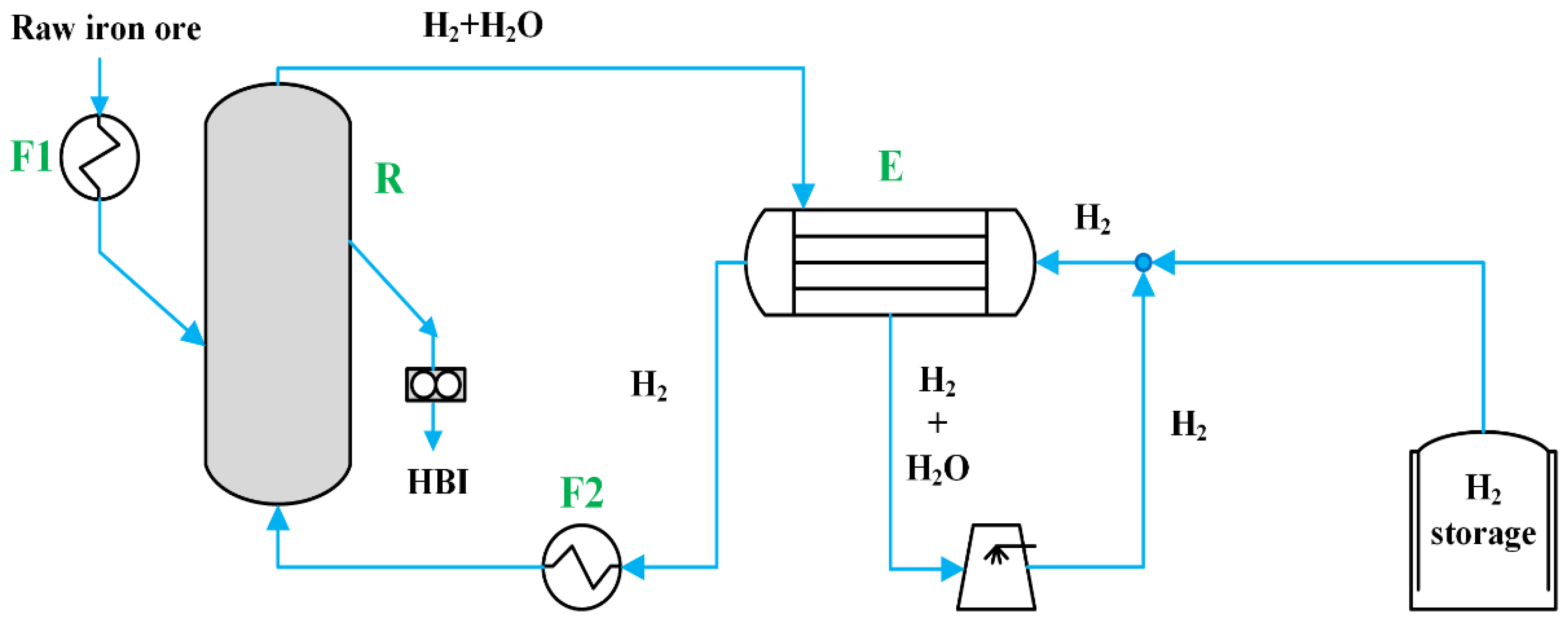
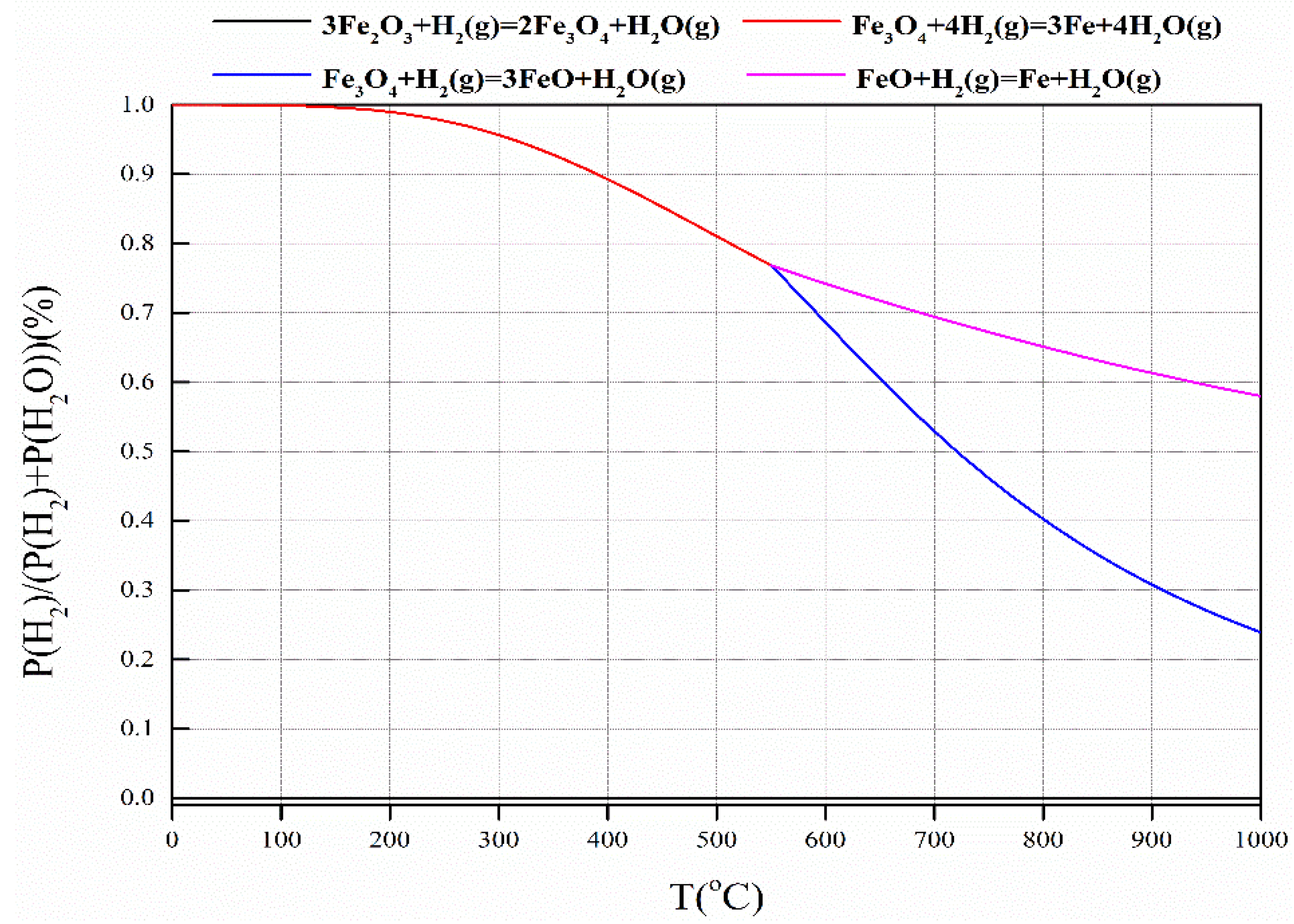

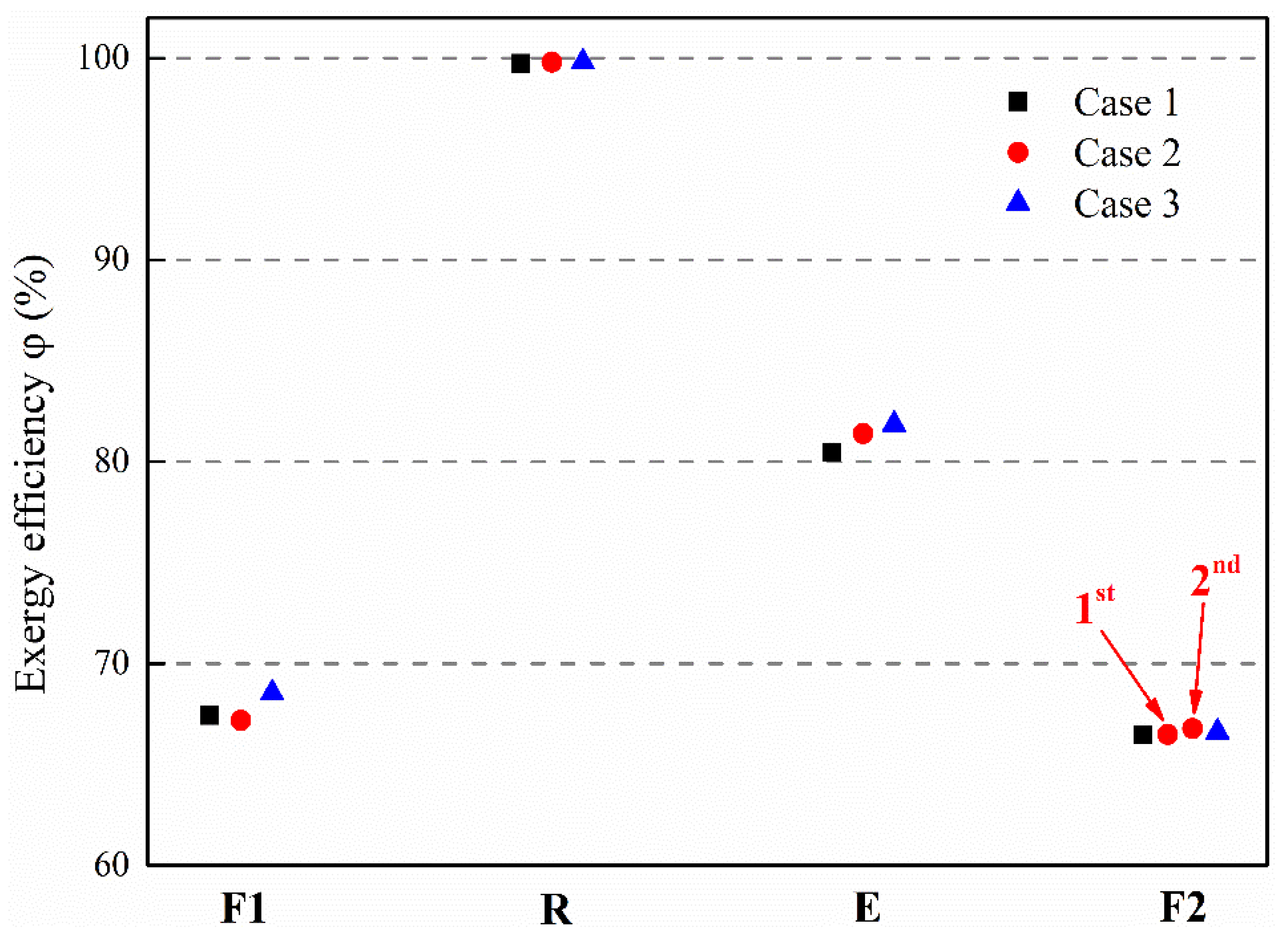
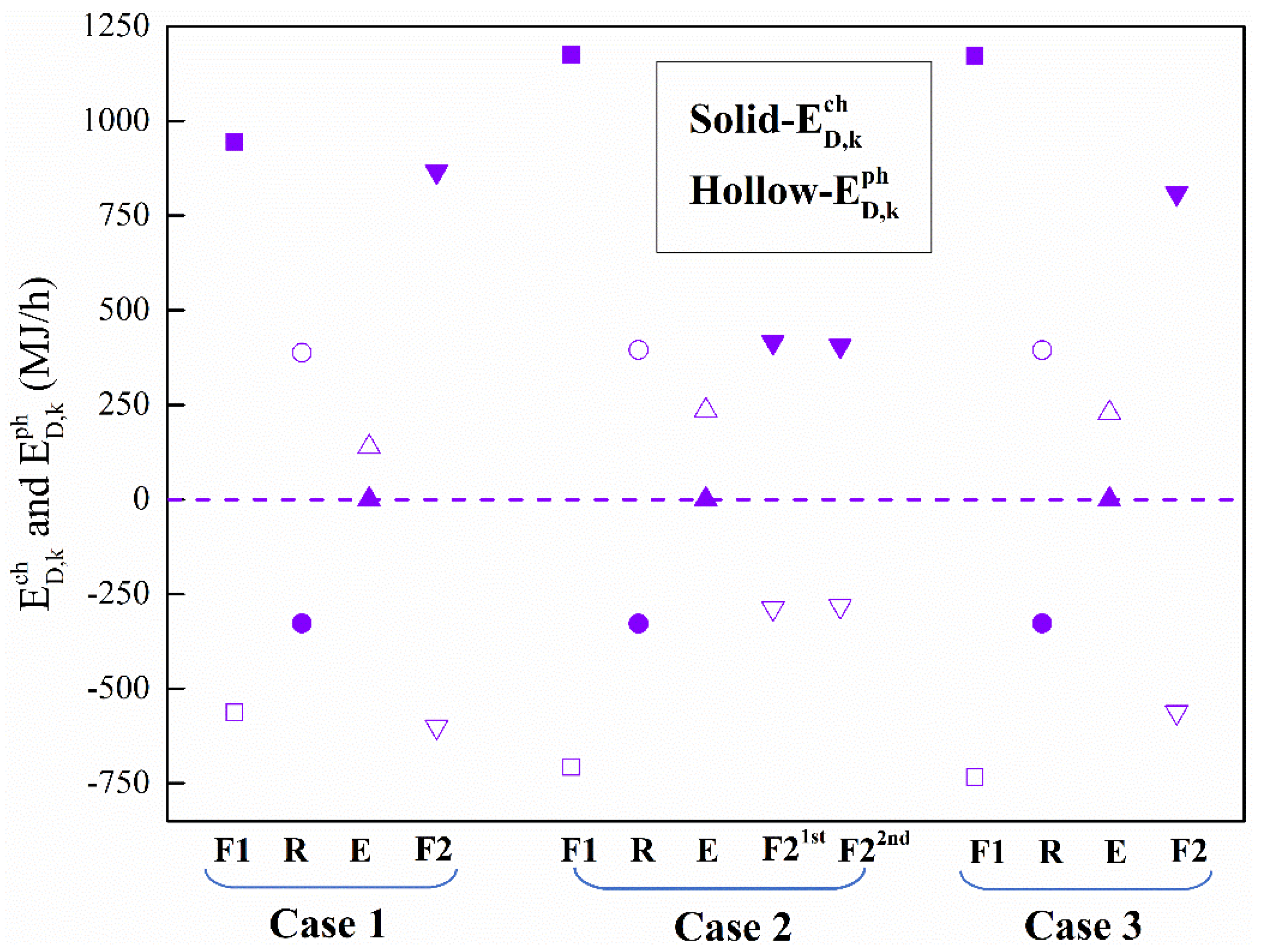
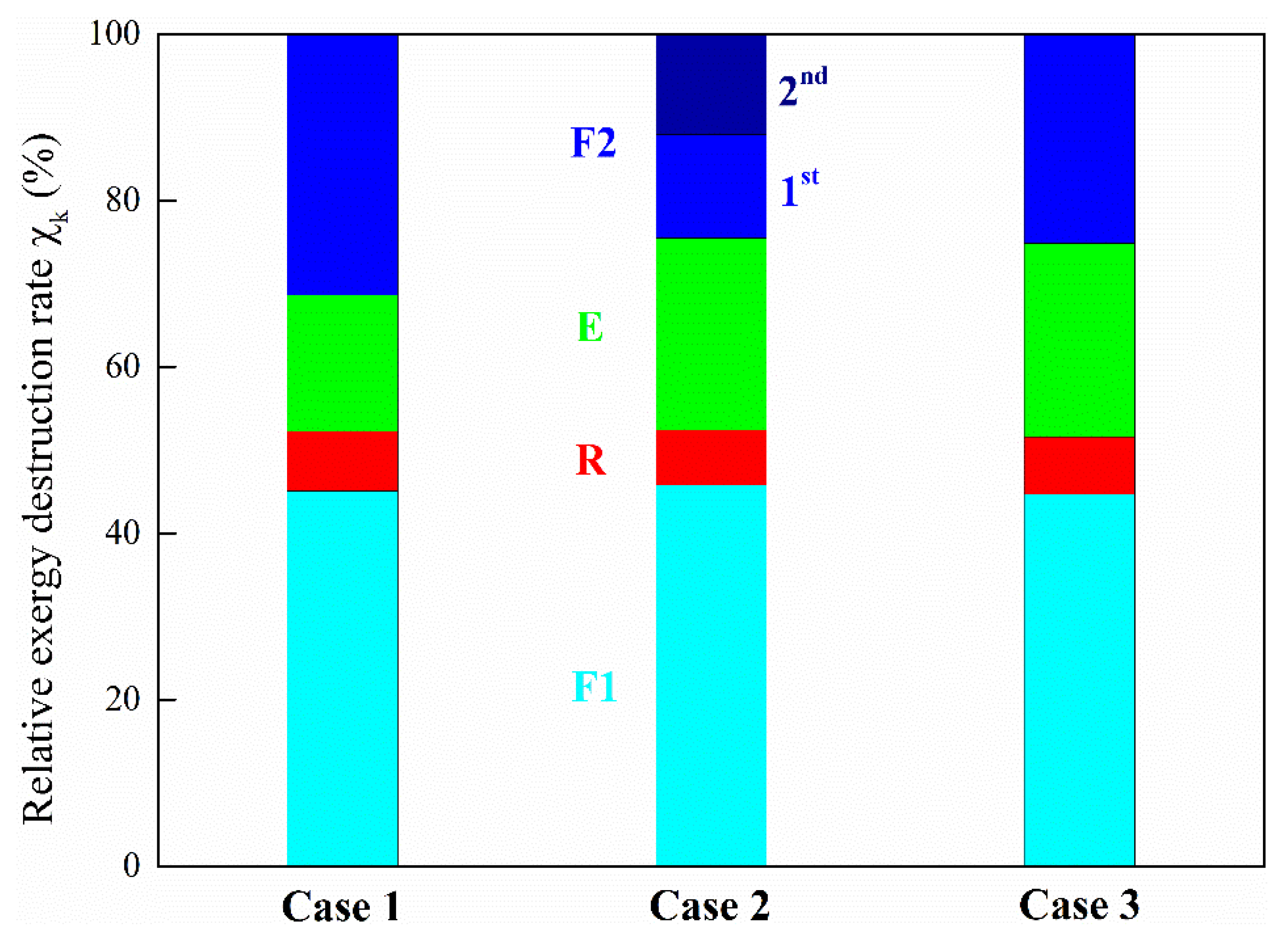



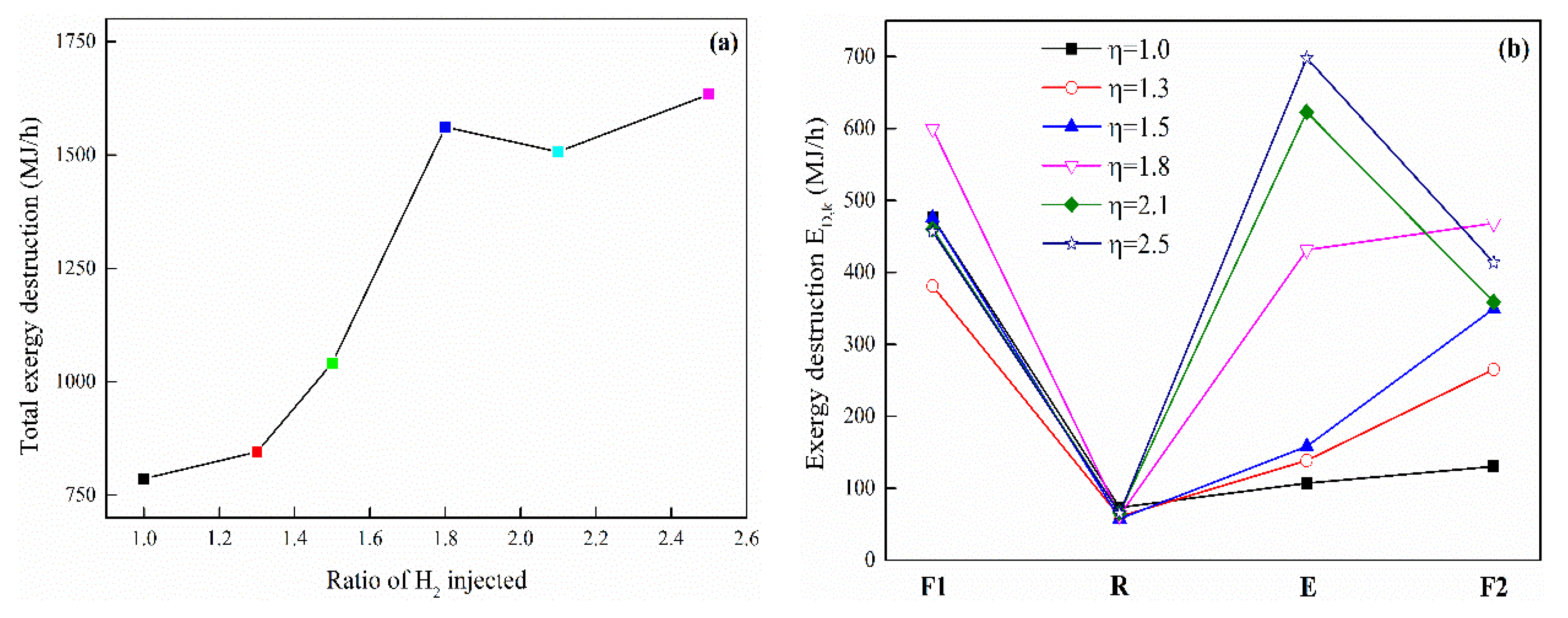
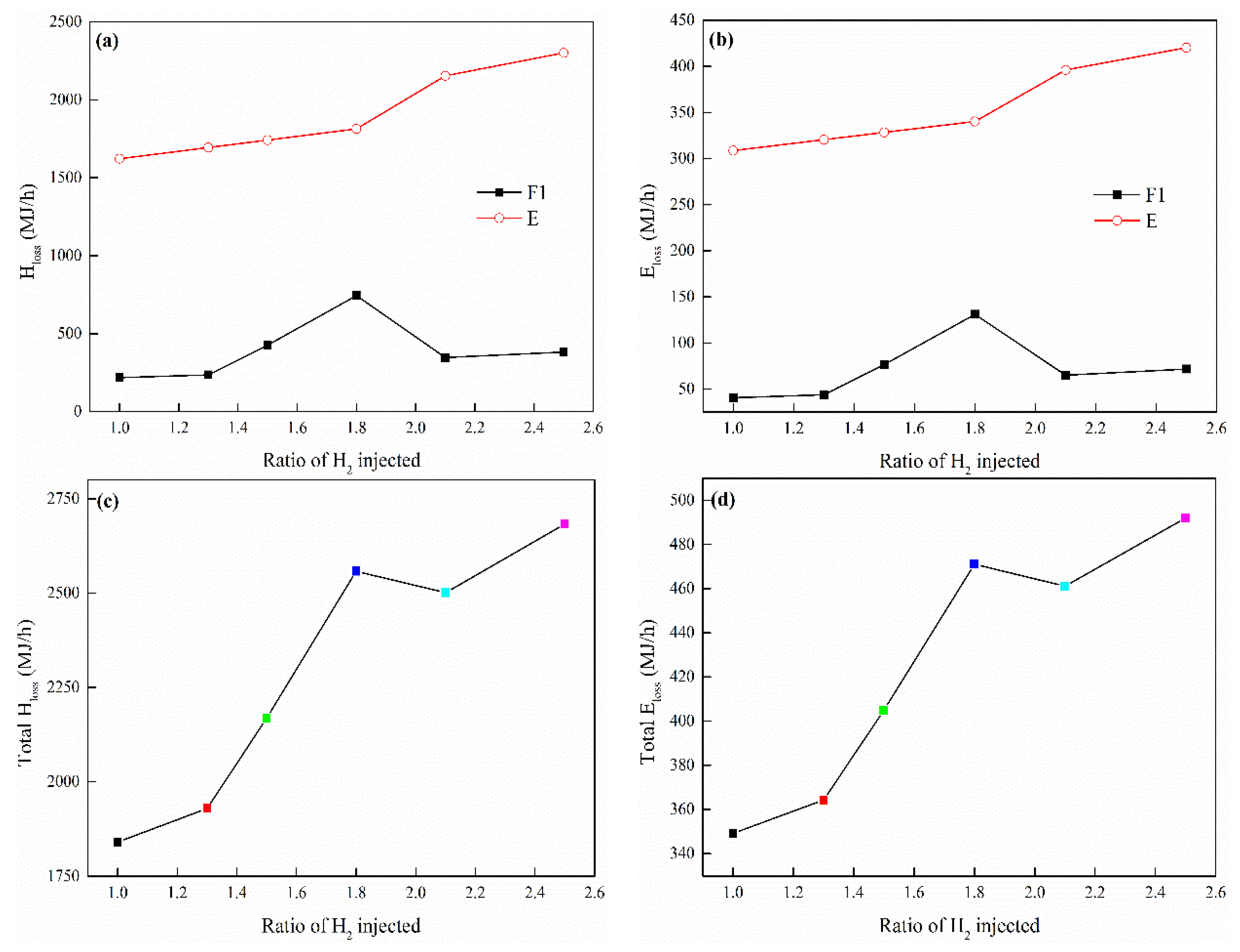
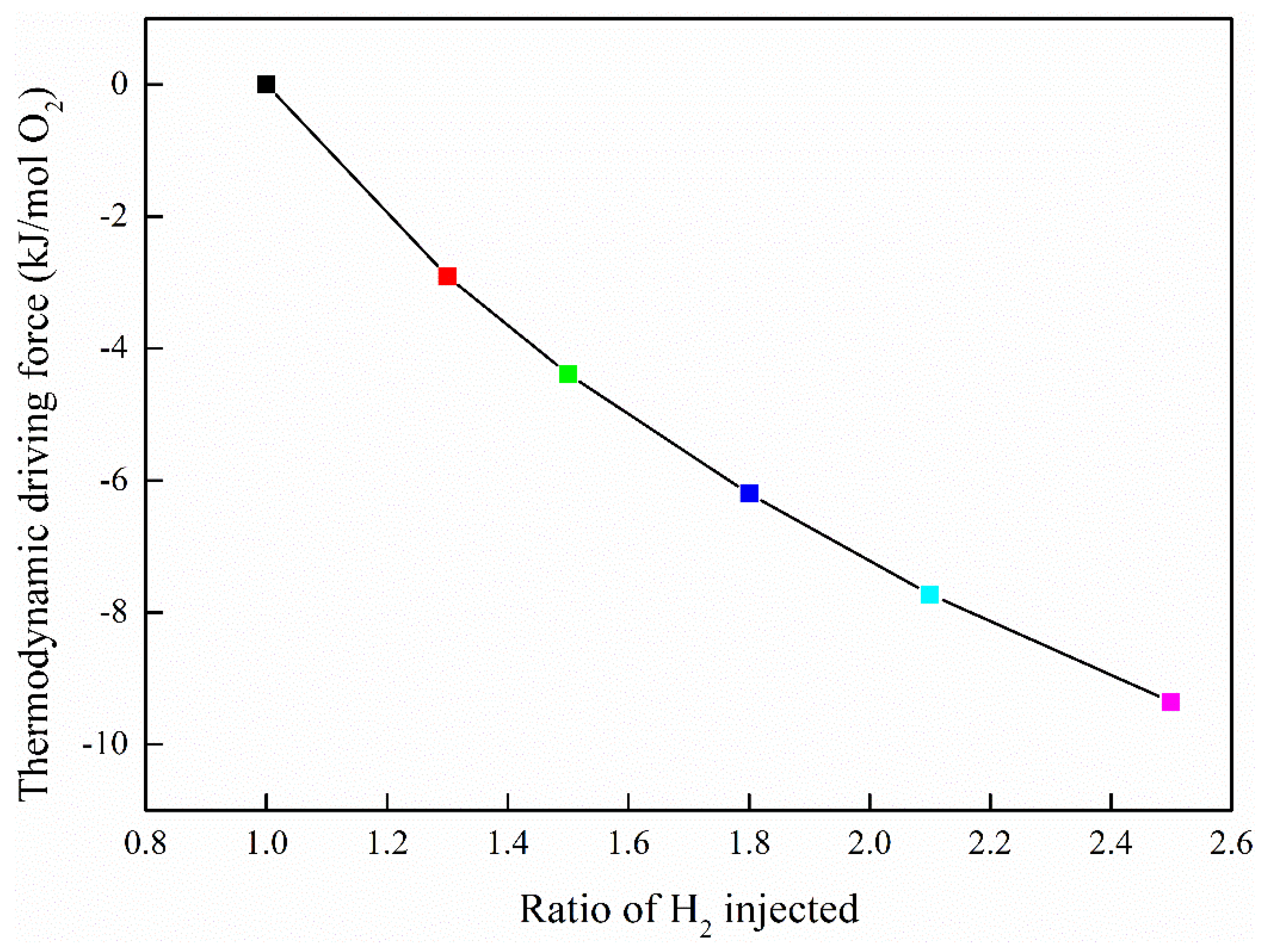
| Formula | a | b | c |
|---|---|---|---|
| Fe2O3 | −825.08 | 9.18 × 10−2 | 1.00 × 10−4 |
| FeO | −268.59 | 5.08 × 10−2 | 6.00 × 10−6 |
| Fe | −85.03 × 10−2 | 3.12 × 10−2 | −3.00 × 10−5 |
| CaO | −636.27 | 4.75 × 10−2 | 3.00 × 10−6 |
| SiO2 | −912.07 | 4.52 × 10−2 | 4.00 × 10−5 |
| MgO | −602.67 | 3.99 × 10−2 | 5.00 × 10−5 |
| Al2O3 | −1687.10 | 8.40 × 10−2 | 5.00 × 10−5 |
| H2 | −67.03 × 10−2 | 2.80 × 10−2 | 2.00 × 10−6 |
| H2O (g) | −242.61 | 3.25 × 10−2 | 6.00 × 10−6 |
| O2 | −78.82 × 10−2 | 2.98 × 10−2 | 3.00 × 10−6 |
| N2 | −68.86 × 10−2 | 2.83 × 10−2 | 3.00 × 10−6 |
| Formula | Chemical Exergies (MJ/kmol) |
|---|---|
| Fe2O3 | 12.4 |
| FeO | 124.9 |
| Fe | 374.3 |
| CaO | 110.2 |
| SiO2 | 2.2 |
| MgO | 59.1 |
| Al2O3 | 15.0 |
| H2 (g) | 236.1 |
| O2 (g) | 4.0 |
| N2 (g) | 0.7 |
| H2O (g) | 9.5 |
| Formula | TFe (Total Iron Content) | Fe2O3 | FeO | CaO | SiO2 | MgO | Al2O3 |
|---|---|---|---|---|---|---|---|
| Concentration (wt.%) | 71.08 | 67.89 | 30.11 | 0.10 | 0.98 | 0.27 | 0.65 |
| Formula | Fe2O3 | Fe | FeO | CaO | SiO2 | MgO | Al2O3 |
|---|---|---|---|---|---|---|---|
| Raw iron ore | 7.17 | 0.00 | 7.07 | 0.03 | 0.28 | 0.11 | 0.11 |
| As-oxidized iron ore | 10.71 | 0.00 | 0.00 | 0.03 | 0.28 | 0.11 | 0.11 |
| Direct reduced iron | 0.00 | 20.34 | 1.07 | 0.03 | 0.28 | 0.11 | 0.11 |
| Metallization Processes | 1st Fluidized Bed | 2nd Fluidized Bed |
|---|---|---|
| Case 1 | λ = 0, FeO | λ = 95% |
| Case 2 | λ = 30%, Fe + FeO | λ = 95% |
| Case 3 | λ = 95% | |
Disclaimer/Publisher’s Note: The statements, opinions and data contained in all publications are solely those of the individual author(s) and contributor(s) and not of MDPI and/or the editor(s). MDPI and/or the editor(s) disclaim responsibility for any injury to people or property resulting from any ideas, methods, instructions or products referred to in the content. |
© 2023 by the authors. Licensee MDPI, Basel, Switzerland. This article is an open access article distributed under the terms and conditions of the Creative Commons Attribution (CC BY) license (https://creativecommons.org/licenses/by/4.0/).
Share and Cite
Du, Z.; Liu, W.; Pan, F.; Zou, Z. Energy and Exergy Analysis of Hydrogen-Based Fluidized Bed Direct Reduction towards Efficient Fossil-Free Ironmaking. Processes 2023, 11, 2748. https://doi.org/10.3390/pr11092748
Du Z, Liu W, Pan F, Zou Z. Energy and Exergy Analysis of Hydrogen-Based Fluidized Bed Direct Reduction towards Efficient Fossil-Free Ironmaking. Processes. 2023; 11(9):2748. https://doi.org/10.3390/pr11092748
Chicago/Turabian StyleDu, Zhan, Wanchao Liu, Feng Pan, and Zheng Zou. 2023. "Energy and Exergy Analysis of Hydrogen-Based Fluidized Bed Direct Reduction towards Efficient Fossil-Free Ironmaking" Processes 11, no. 9: 2748. https://doi.org/10.3390/pr11092748



